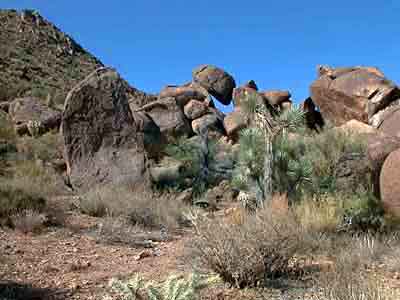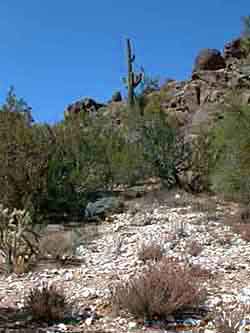GEOGRAPHY AND GEOLOGY
The area is characterized by flat to gently sloping terrain punctuated by occasional granitic outcrops and small to medium-size hills. The hills are geologically related to the main body of the Hualapai Mountains, one of the highest mountain ranges in northwestern Arizona, topping out at over 8400 feet at the summit of Hualapai Peak. The hills surrounding D:FR are distinct from the main Hualapai Mountain chain, separated from them in many cases by flat outwash plains of sand and gravel eroded from the mountains by millennia of flash floods. The area has a unique look, and it is possible for parcels in the region to have both steep, rocky hillsides and flat sandy plains with a few yards of sloping transition terrain connecting them. D:FR is located on just such a property.
One of the characteristics that makes the physical location of Destination: Forever Ranch so interesting is the rocky ridgeline that the site encompasses. There are two hills flanking D:FR, located less than one-half mile apart. The hill to the northwest is lower, reaching about 3320 feet at its summit. The hill to the southwest is taller, at about 3540 feet. It is the connecting ridge between the two that D:FR occupies. As has been noted, the property is 40 acres in size, and was chosen in large part for its geological characteristics and diverse habitats created by being both flat and hilly. All four exposures are present on the site, a characteristic that will greatly increase the niche diversity available for planting. Some plants will appreciate the warmer south and west slopes amongst the protection of large rocks, whereas others will prefer the cooler north slopes in the shade of similar rocks. Some plants want deep, sandy soil, others will want denser clay derived from the weathered granite, and yet others like shallow and rocky sites.
 |
|
A natural rock arch spans an outcrop on the ridge above the gardens. The opening measures about 6 feet wide by 10 feet tall View from under the arch |
The rocks are granitic, composed of primarily two types of granite. One type is a coarser-grained pinkish stone, known as the Cellar-Topock formation, that tends to form large monolithic boulders, often rounded or ovoid in shape. The other type, named the Wikieup complex, has a finer grain and is more jagged and irregular. Clefts and fissures appear in both types, but the Cellar-Topock has a greater propensity for forming large dramatic stacks of roundish shapes. The Wikieup complex is more likely to form interesting weathered spires and pyramidal piles with steps up to the summit of the piles. The Cellar-Topock granite is the less common type. The arch in the picture is composed of Cellar-Topock granite and is located atop the ridge just above the site of future buildings, which themselves will be in and amongst the boulders of the same type of granite.
|
Weathered quartz fragments litter the slope in patches at D:FR |
|
|
Quartz is also common on the D:FR site. Shot through both types of granite in large veins, some spots are nearly white with weathered-out fragments of nearly pure white quartz. Crystals are rare, however, and tend to be poorly formed if present. Gold, often associated with quartz in granite, is not present, which no doubt has much to do with accounting for the undisturbed nature of the D:FR site!
SOIL TYPES
There are three main classifications of soil type on the D:FR property. Deep and sandy soils prevail over about 40% of the property where a rather large wash complex crosses the eastern half of the site. These are easy to dig in and exceptionally well-drained. Water poured onto the sand, which is quite coarse in texture, disappears almost immediately. There are some spots, usually slightly elevated above the braided wash channels, that have a fair component of loam and silt mixed in with the sand, and these tend to be a bit better at retaining moisture. Joshua trees (Yucca brevifolia) and one-seeded juniper trees (Juniperus monosperma) reach their largest sizes and best development in the sandy soils. Certain cacti, such as the Christmas cholla (Opuntia leptocaulis) and the diamond cholla (O. ramosissima) as well as shrubs like wolfberry (Lycium species) and Colorado four o’clock (Mirabilis multiflora) are restricted to this soil type, not being found elsewhere on the property.
The second soil type is not easy to classify as a soil at all, being composed primarily of rocks and gravel with a sparse filling of sand and decomposed granite between them. Despite this seemingly impoverished environment, there are many plants that prefer these ecological conditions The rocky ridgeline that comprises this substrate covers roughly 45% of the 40 acres, and is home to the saguaro cactus (Carnegiea gigantea), most of the compass barrel cacti (aka red barrels, Ferocactus acanthodes), and bigelow nolina (Nolina bigelovii), as well as shrubs like yellow bush snapdragon (Keckiella antirrhinoides), desert lavender (Hyptis emoryi) and brittlebush (Encelia farinosa). These and many other plants refuse to grow in the wash areas, just as the wash plants refuse to perform well up on the slopes.
The last soil type covers a relatively small area, only about 15 % of the D:FR property. It is a transition type of soil that comes down off the rocky slopes and terminates at the sandy flats. The soil is mostly a sticky red clay, which is a common soil type derived from its granitic parent rocks. Hard as adobe when dry, after rains it softens up nicely and digs easily. There are many rocks mixed in with this soil, ranging from egg-sized to about as big as a microwave oven, but there is lots of room between the larger rocks. It is hard to dampen due to its density, but it also retains water much better than the sandy soils below it, and is also fairly rich in nutrients. Plants that favor this soil type include dense groves of buckhorn cholla (Opuntia acanthocarpa), banana yucca (Yucca baccata) and ocotillo (Fouquieria splendens).
